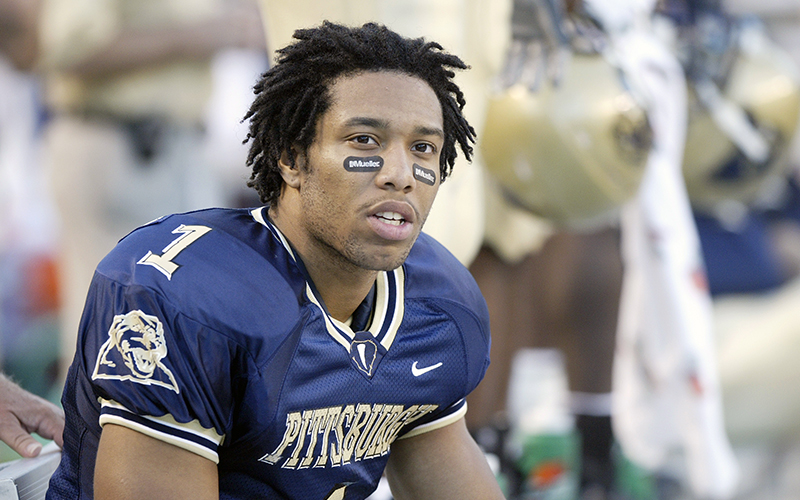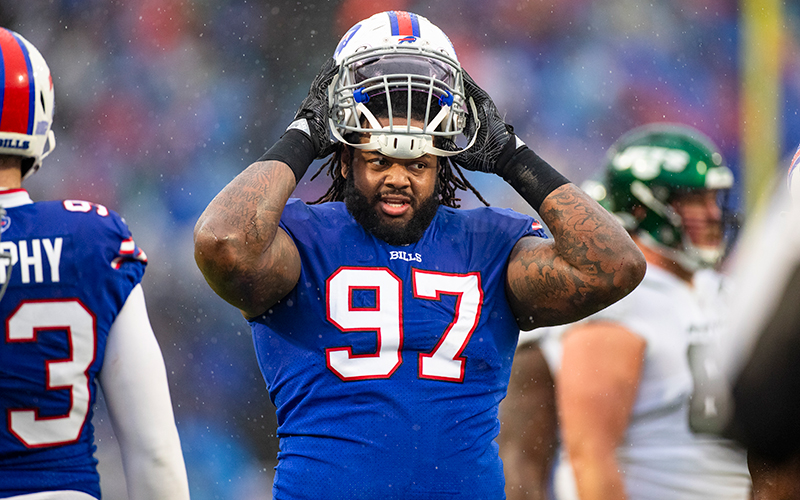
Wide receiver Larry Fitzgerald always was on the radar of Dennis Green, who was the Arizona Cardinals coach in 2004. Green watched Fitz when he was a ball boy for the Minnesota Vikings and later a standout receiver for the University of Pittsburgh. (Photo by George Gojkovich/Getty Images)
With the sports world on hold, Cronkite News will take a daily look at this day in sports history and reflect on some of the biggest moments in Arizona sports.
PHOENIX – Dennis Green made a promise to Larry Fitzgerald Sr. on April 24, 2004.
“‘If your son’s there at No. 3,” Fitzgerald Sr. remembers the late Green, then the head coach of the Arizona Cardinals, telling him, “we’re taking him.”
The Cardinals owned the third pick in the 2004 NFL Draft, their fingers crossed that the nation’s top receiver would fall into their lap.
The San Diego Chargers selected Eli Manning with the first pick and the Oakland Raiders chose Robert Gallery before the Cardinals made it official, selecting the University of Pittsburgh’s Larry Fitzgerald Jr.

Sixteen years later, the Cardinals have watched their first-round choice help carry the team to a Super Bowl in 2009, push the team to several division titles and cement himself as one of the game’s best wide receivers.
“Larry’s been a part of this transition, this growth, of big-time football in the desert,” his father said in an interview with Cronkite News.
There was uncertainty that Fitzgerald would be available to the Cardinals at No. 3. The belief among both camps was that the Raiders were inclined to select him with the second pick. When they instead plucked Gallery, a defensive tackle from Iowa, it was a no-brainer for Arizona to choose Fitzgerald.
A year before as a sophomore at Pitt, the 6-foot-3 All-American hauled in 92 receptions for 1,672 yards and 22 touchdowns, narrowly losing the Heisman Trophy vote to Oklahoma quarterback Jason White.
But the Fitzgerald-Cardinals connection stretches back far before Arizona tabbed him as its beacon of hope.
As a child, Fitzgerald was a ball boy for the Minnesota Vikings when his father, a sports journalist, had a radio show in Minnesota with Green when he was coach of the Vikings.
“Denny had a knowledge of who Larry was from high school,” the elder Fitzgerald said. “From that standpoint, years later, here’s Larry now developed, ready to go into the pros. Denny had a knowledge of who he was drafting.”
It was hard to ignore the talent and raw skill set Fitzgerald boasted. He was big, freakishly athletic and could run well for his size. His father saw the NFL potential in him as a high-schooler. A lot of it can be credited to his days as a ball boy, where he had a front-row seat to study Vikings’ superstars Cris Carter and Randy Moss.
“Being around people like that who are pros,” his father said, “when you’re a high school kid, they get excited about you because they can see your potential, and then on the flip side, they got to see what he had a chance to do because he was their ball boy. He would catch balls with them and stuff like that.”
Rod Rutherford, Fitzgerald’s quarterback at Pitt, said he remembers how effortless it was throwing to his star receiver.
“(I had) everything I needed in just one guy,” he said. “It felt like once every game, he made a catch where you went, ‘Wow, only he can do that.'”
Rutherford particularly remembers a game against Virginia Tech where Fitzgerald caught three touchdowns, including an acrobatic over-the-shoulder grab. There was another time versus Texas A&M where Fitzgerald, swarmed by three defenders, still managed to snag a Rutherford pass.
It was stuff out of video games, memories Rutherford remembers vividly. The NFL potential was evident early on.
“It wasn’t arrogance,” he said. “It was true confidence. It was, ‘I’m better than you,’ but not in-your-face type of thing. For him to have success as fast and for as long as he’s had it, you were able to see that early on.”
Fitzgerald, an 11-time Pro Bowler, is the Cardinals’ all-time leading receiver in games (250), receptions (1,378), yards (17,083) and touchdowns (120), according to Pro Football Reference.
Fitzgerald ranks second behind Jerry Rice for the most receiving yards in NFL history. Perhaps the most eye-popping of his career stats, per Pro Football Focus, is that he’s logged more tackles (39) than dropped passes (29).
Following Green’s death in 2016, Fitzgerald honored his first NFL coach with a message in which he thanked Green for giving him the only two jobs of his life – ball boy for the Vikings and wide receiver for the Cardinals.
Fitzgerald has also been rooted in the community since his arrival to Arizona. He’s been involved with lots of charity work, including his own First Down Fund. It promotes “reading proficiency and technology access for K-12 youth as cornerstones to success at school and in life,” while also “supporting efforts to prevent and cure breast cancer and support breast cancer survivors,” according to LarryFitzgerald.com.
Fitzgerald lost his mother, Carol, to breast cancer in 2003.
Now 36, Fitzgerald made it official he’ll be back for the Cardinals in 2020, staving off retirement, by signing a one-year deal in January. It will mark his 17th season in the league, all with the Cardinals.
It’s safe to say Arizona’s 2004 investment in the wideout has paid dividends – and then some.
“It’s meant a great deal,” his father said of the Fitzgeralds being part of the Cardinals family.
It will one day be permanent, when No. 11 is enshrined in Canton, Ohio, in the Pro Football Hall of Fame, as one of football’s best.

